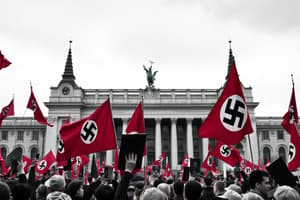Podcast
Questions and Answers
What political structure is fascism primarily based on?
What political structure is fascism primarily based on?
- Collective decision-making
- Dictatorship of a single party (correct)
- Democratic representation
- Decentralized governance
Which of the following ideologies is closely associated with the concept of racial superiority?
Which of the following ideologies is closely associated with the concept of racial superiority?
- Nazism (correct)
- Fascism
- Libertarianism
- Socialism
What was a significant consequence of fascism's authoritarian rule?
What was a significant consequence of fascism's authoritarian rule?
- Emphasis on individual rights
- Establishment of socialist communities
- Strong police state and security measures (correct)
- Promotion of universal suffrage
Who is the prominent leader associated with the establishment of Nazism in Germany?
Who is the prominent leader associated with the establishment of Nazism in Germany?
What policy is not typically supported by fascist regimes?
What policy is not typically supported by fascist regimes?
What was a characteristic of totalitarian ideologies like Nazism and fascism?
What was a characteristic of totalitarian ideologies like Nazism and fascism?
How did fascism define its stance towards foreigners?
How did fascism define its stance towards foreigners?
What term is often used to describe authoritarian regimes similar in form to Italian fascism?
What term is often used to describe authoritarian regimes similar in form to Italian fascism?
What is a key characteristic of totalitarianism?
What is a key characteristic of totalitarianism?
What does socialism primarily aim to reform?
What does socialism primarily aim to reform?
Which of the following describes communism in its original meaning?
Which of the following describes communism in its original meaning?
What term is used to describe the political regime ruled by a single party with absolute power?
What term is used to describe the political regime ruled by a single party with absolute power?
What is the transitional period called in Marxist theory that follows the abolition of capitalism?
What is the transitional period called in Marxist theory that follows the abolition of capitalism?
What principle does socialism advocate concerning social structures?
What principle does socialism advocate concerning social structures?
Which political doctrine is primarily associated with the concept of collective ownership?
Which political doctrine is primarily associated with the concept of collective ownership?
What characteristic is commonly associated with totalitarian regimes such as Italian Fascism and the Stalinist regime?
What characteristic is commonly associated with totalitarian regimes such as Italian Fascism and the Stalinist regime?
Flashcards
Fascism Definition
Fascism Definition
A totalitarian regime, usually authoritarian and nationalistic, characterized by a single-party dictatorship, rejection of human rights, and a strong police state. Often distrustful of foreigners.
Fascism Origins
Fascism Origins
Developed after World War I in Italy, led by Benito Mussolini.
Nazism Definition
Nazism Definition
A totalitarian ideology emphasizing the superiority of one race, territorial expansion, and the extermination of other groups.
Nazism Origins
Nazism Origins
Signup and view all the flashcards
Totalitarianism
Totalitarianism
Signup and view all the flashcards
Propaganda
Propaganda
Signup and view all the flashcards
Authoritarianism
Authoritarianism
Signup and view all the flashcards
Nationalism
Nationalism
Signup and view all the flashcards
Totalitarian State
Totalitarian State
Signup and view all the flashcards
What is the origin of Totalitarianism?
What is the origin of Totalitarianism?
Signup and view all the flashcards
Socialism
Socialism
Signup and view all the flashcards
Marxist Socialism
Marxist Socialism
Signup and view all the flashcards
Communism
Communism
Signup and view all the flashcards
Difference between Socialism and Communism
Difference between Socialism and Communism
Signup and view all the flashcards
Proletariat
Proletariat
Signup and view all the flashcards
Study Notes
Fascism
- Originated from the Italian word "fasci," meaning emblems of authority in ancient Rome.
- A regime established by Benito Mussolini in Italy from 1922 to 1945, following World War I.
- Based on a single-party dictatorship, authoritarianism, nationalism, and anti-communism.
- Rejected human rights and characterized by a strong, security-based police state.
- Involved a vertical trade organization into corporations and a distrust of foreigners.
- Represents a reactionary policy.
- Considered a form of totalitarianism.
- The term "fascist" is used to describe similar authoritarian, totalitarian regimes.
Nazism
- Derived from the German word "Nationalsozialismus."
- The totalitarian ideology of the National Socialist German Workers' Party (NSDAP).
- Formed in Germany in 1919.
- Developed by Adolf Hitler, outlined in his autobiographical book "Mein Kampf" (1925).
- Centered on the superiority of the "Aryan race," conquest of "living space," and extermination of "inferior" races and peoples.
- Established a totalitarian political dictatorship in Germany from 1933 to 1945.
- Strongly influenced by Italian fascism.
- Promoted German nationalism, prioritizing the group over the individual, and fanatical devotion to Adolf Hitler ("Führer").
- Racist and anti-Semitic.
- Hostile to press freedom, democracy, universal suffrage, trade unionism, liberalism, and communism.
- Sought to unite social classes into a homogeneous national community.
- A far-right ideology with interpretations as a specific totalitarian system and/or a form of fascism.
Anti-Semitism
- "Anti-Semitism" combines the prefix "anti-" (meaning against) and "Semitism" (referring to the Semitic peoples).
- The Semitic peoples include various ancient and modern groups from Southwest Asia, including Akkadians, Canaanites, Phoenicians, Hebrews, and Arabs.
- A systematic expression of aversion towards Jews as a people or race.
- Can take various forms including opposition, hostility, discrimination, racism, and persecution (e.g., ghettos, pogroms).
- It is based on a denial of the right to be different.
Studying That Suits You
Use AI to generate personalized quizzes and flashcards to suit your learning preferences.




